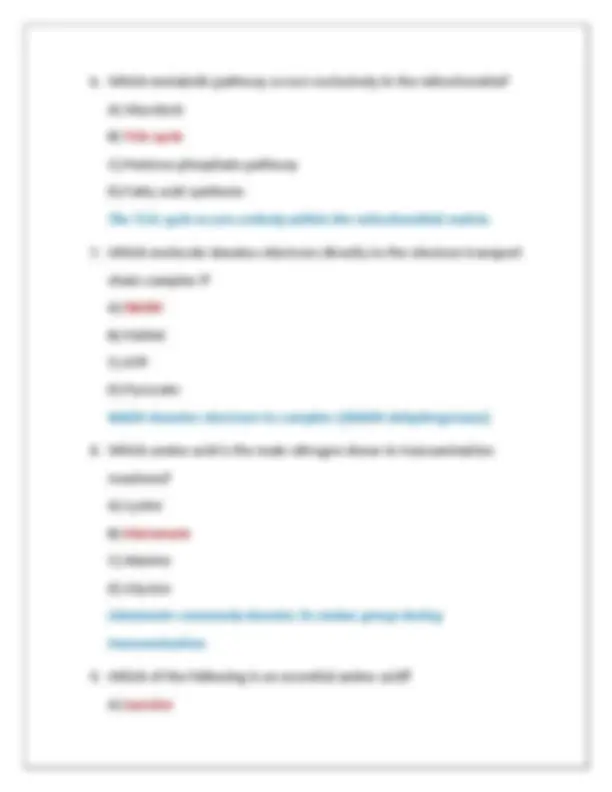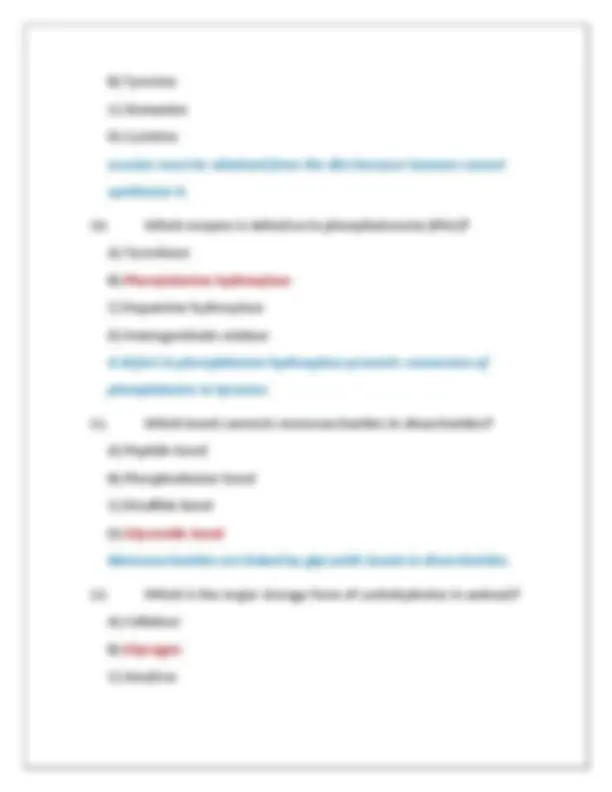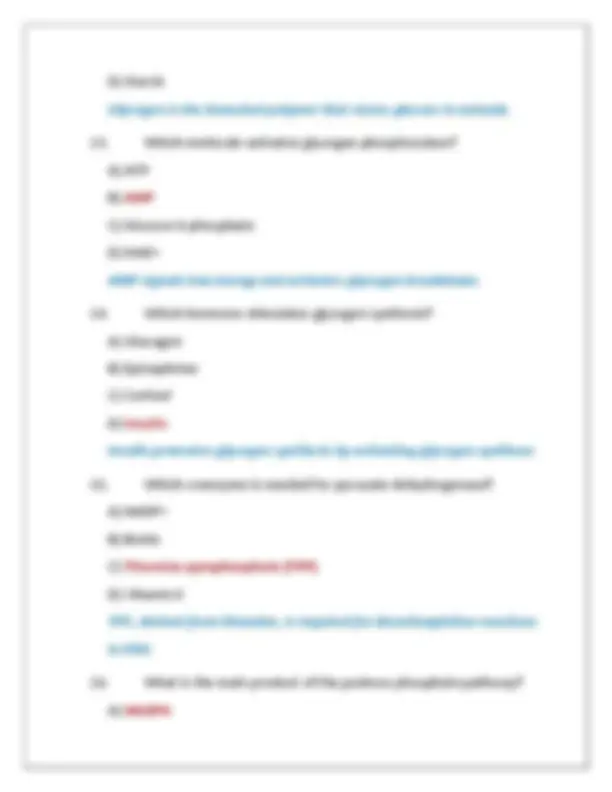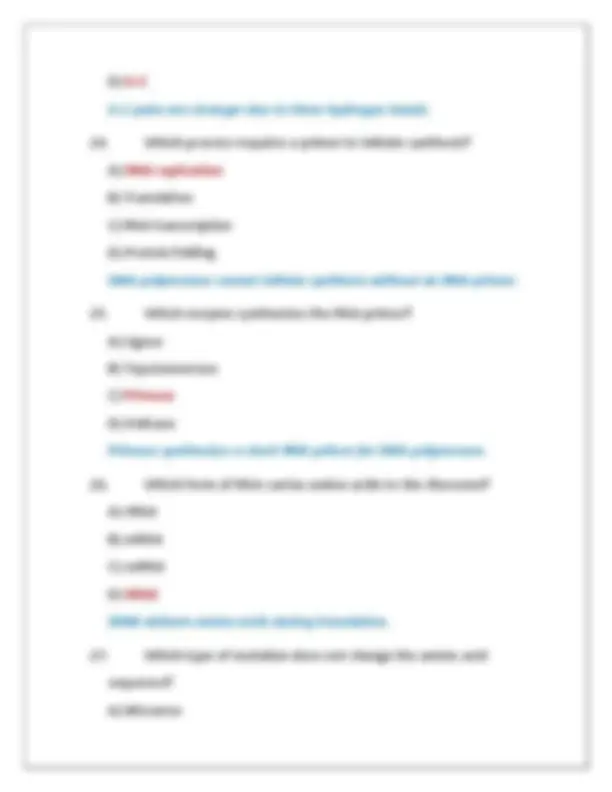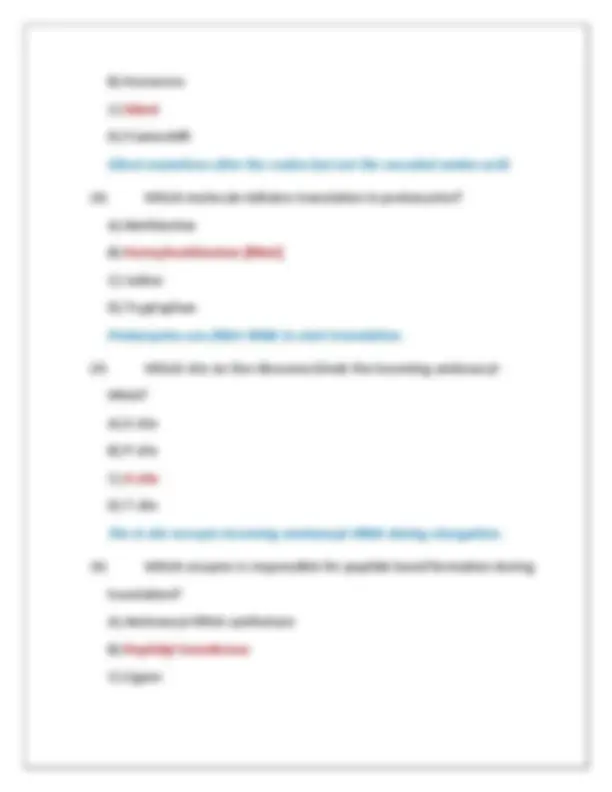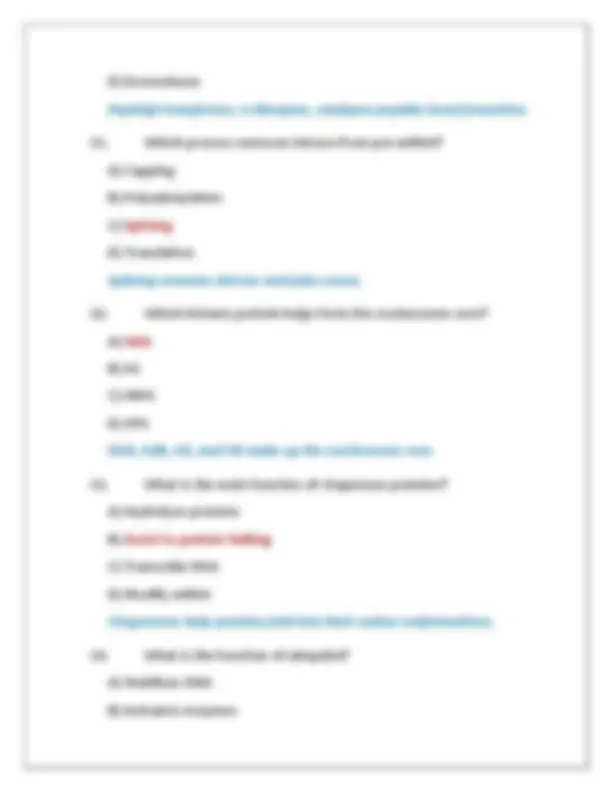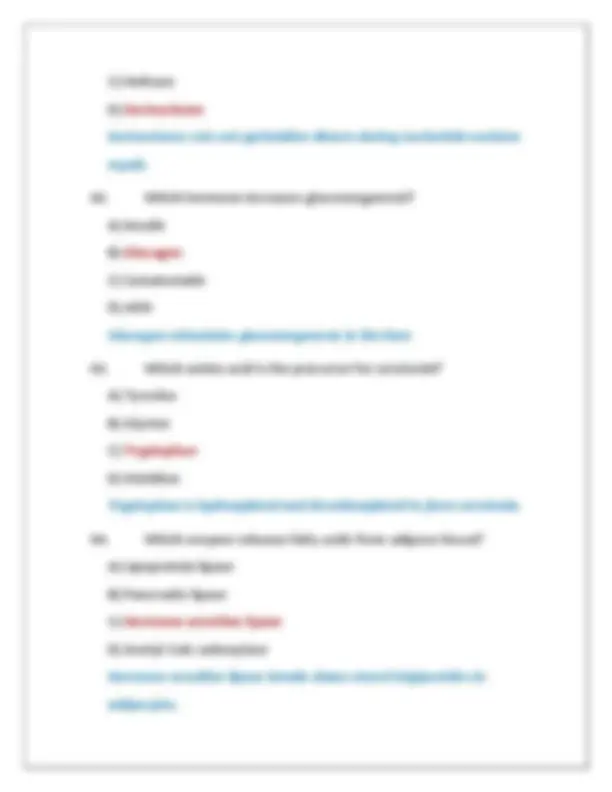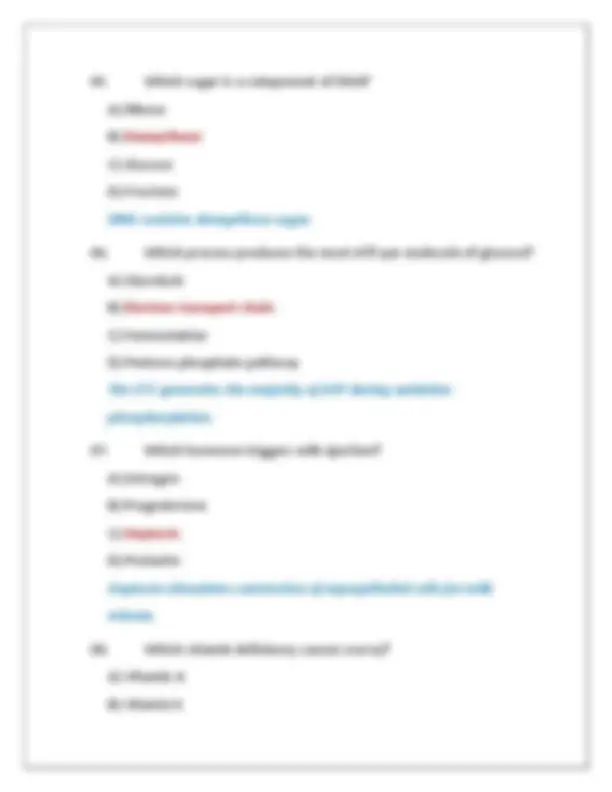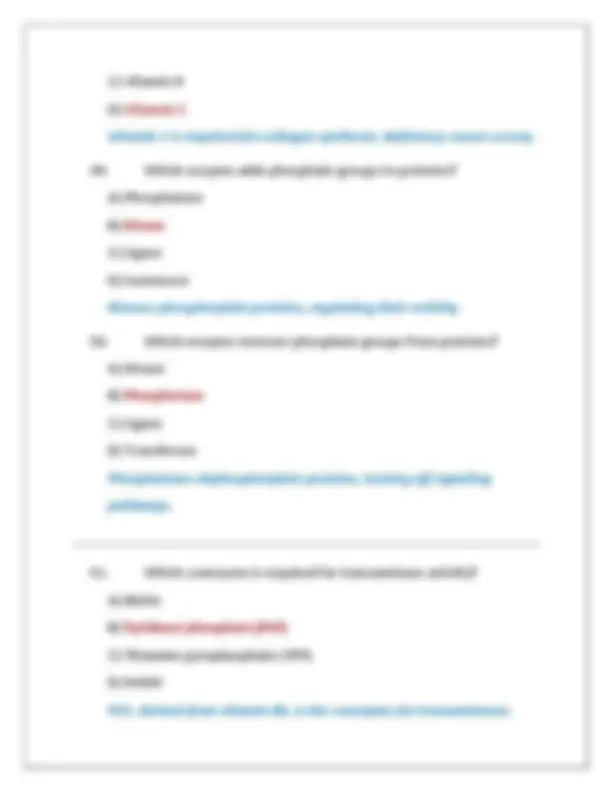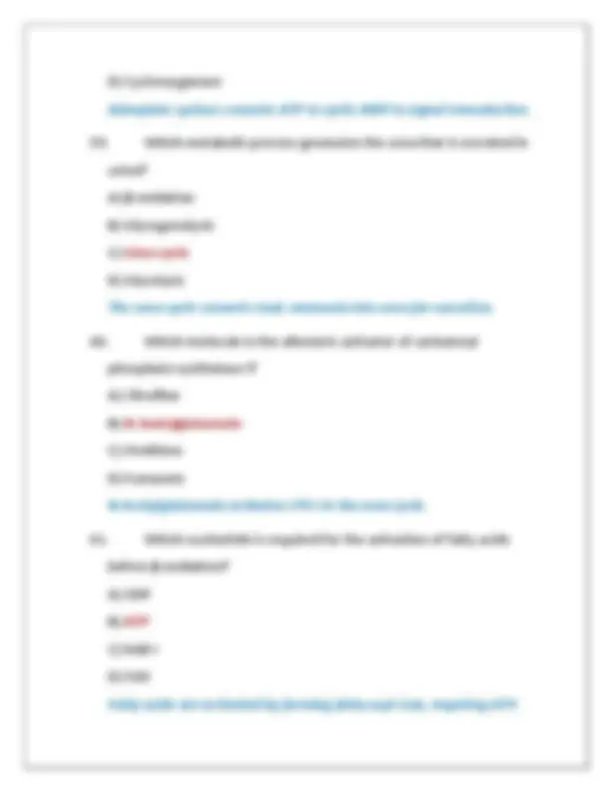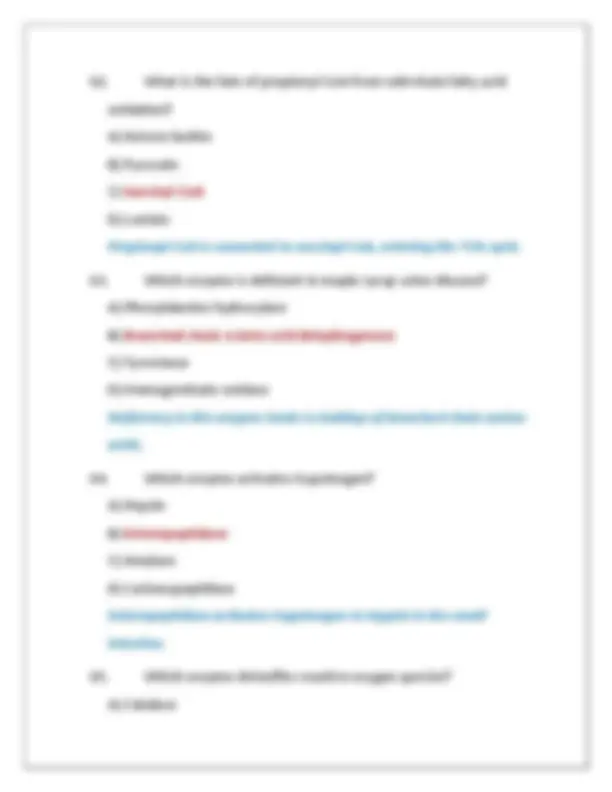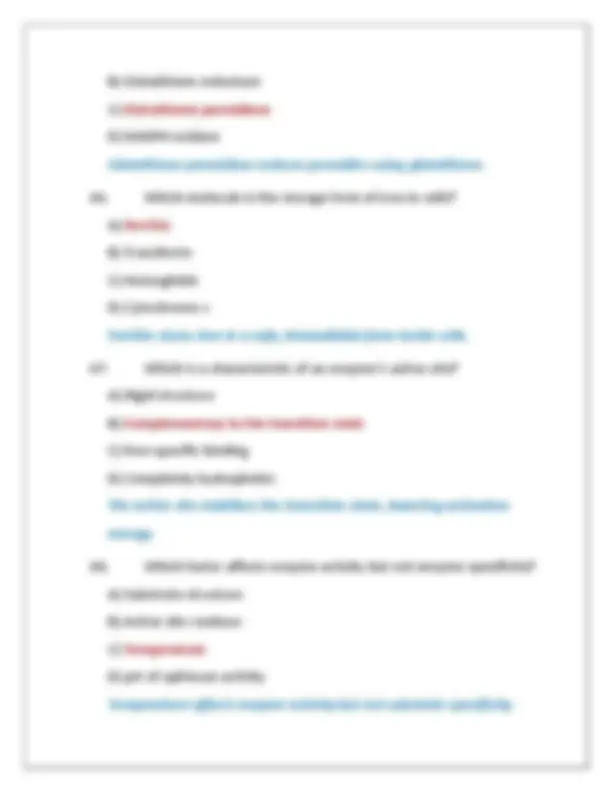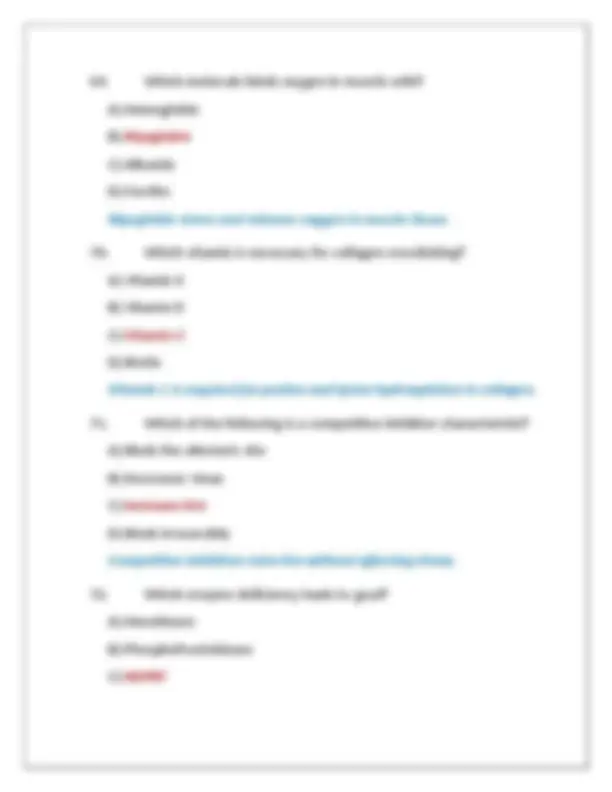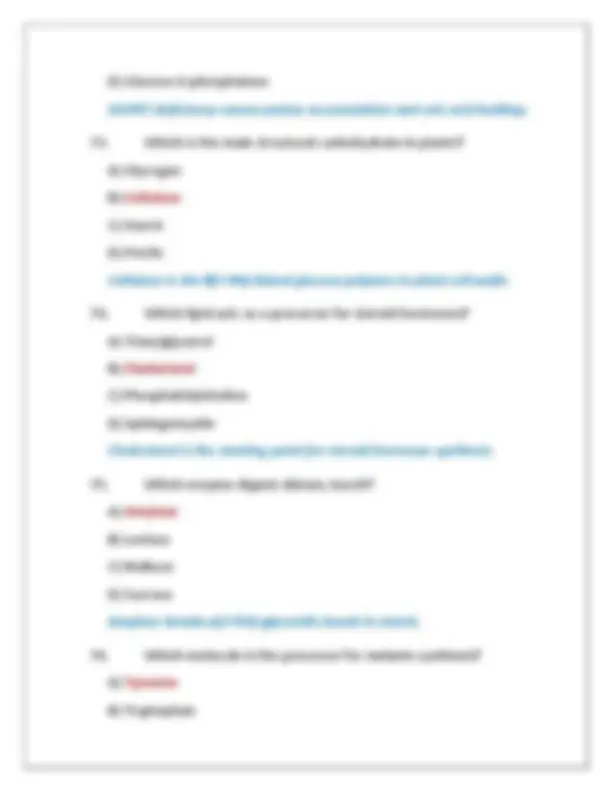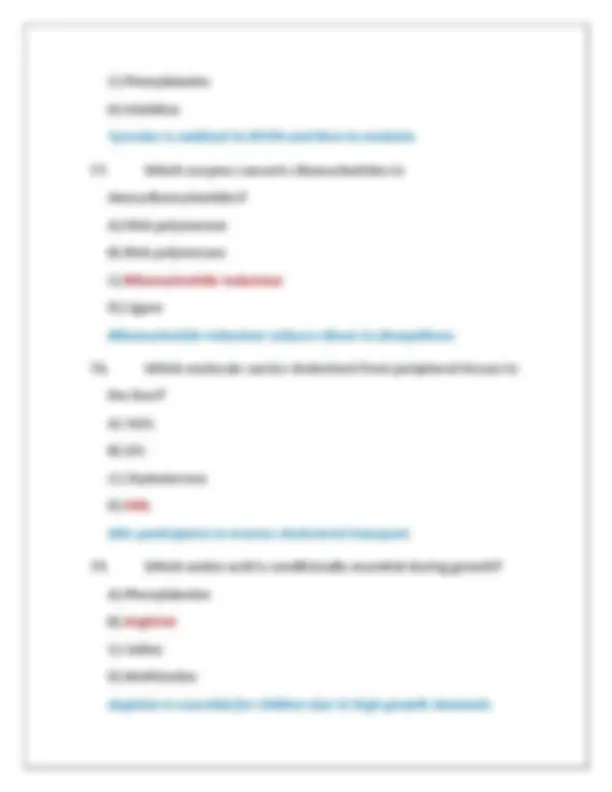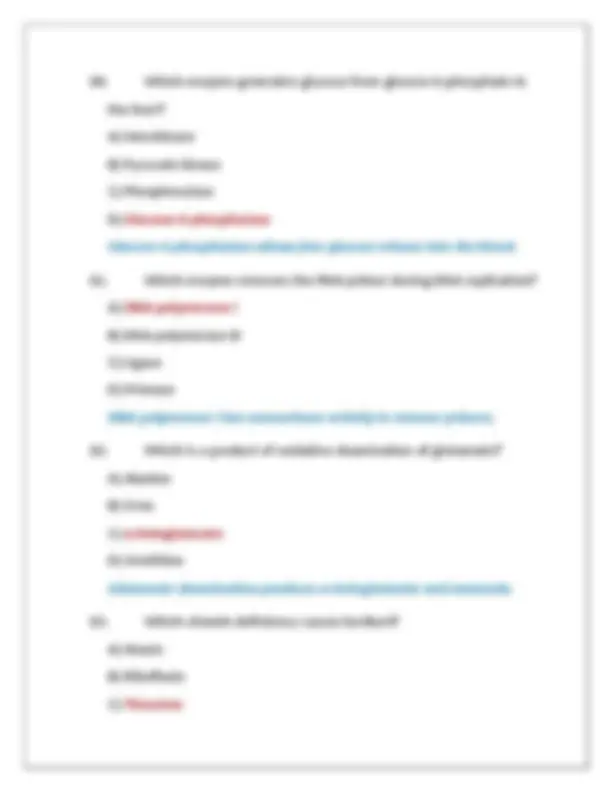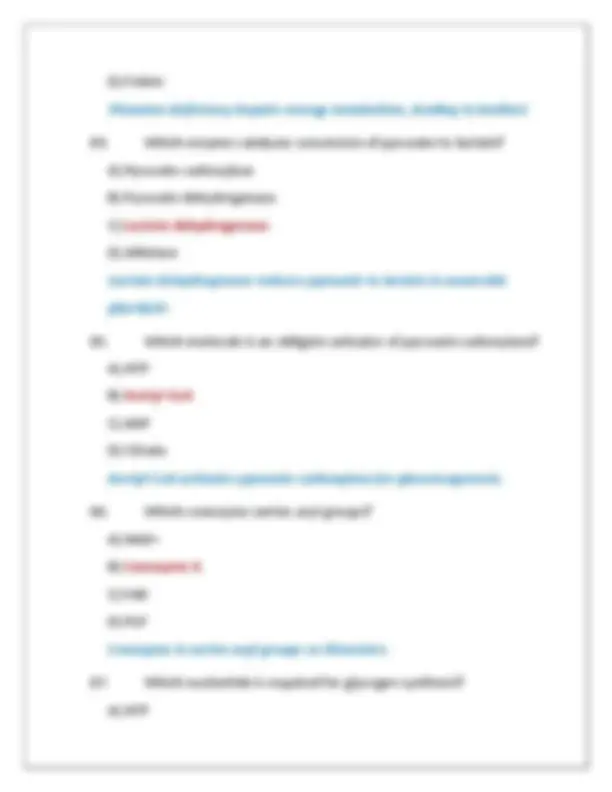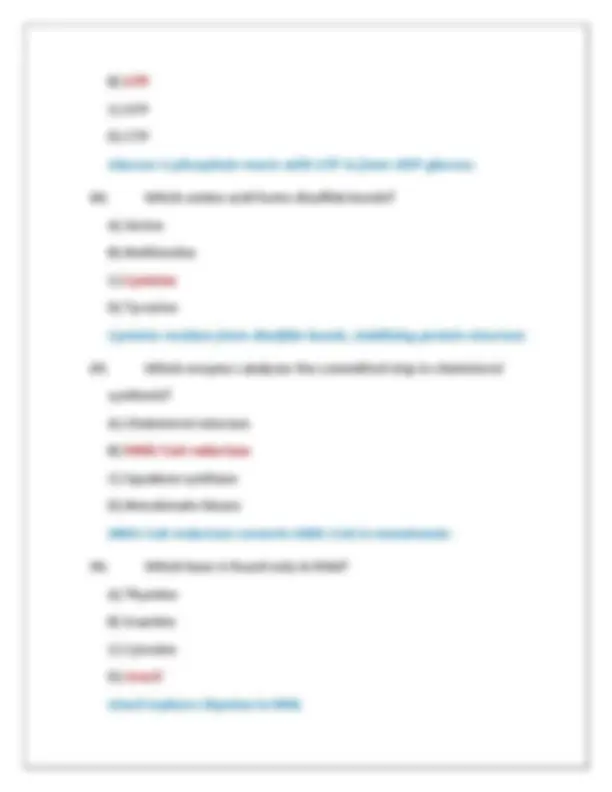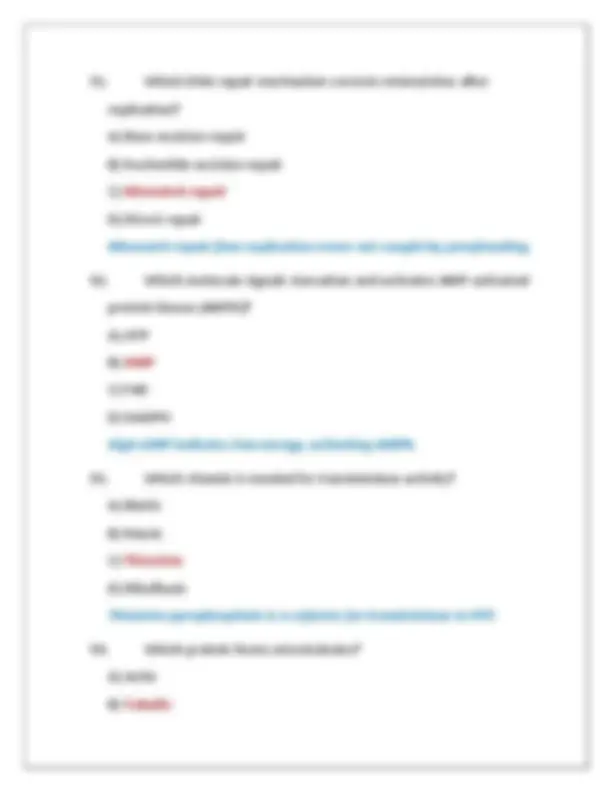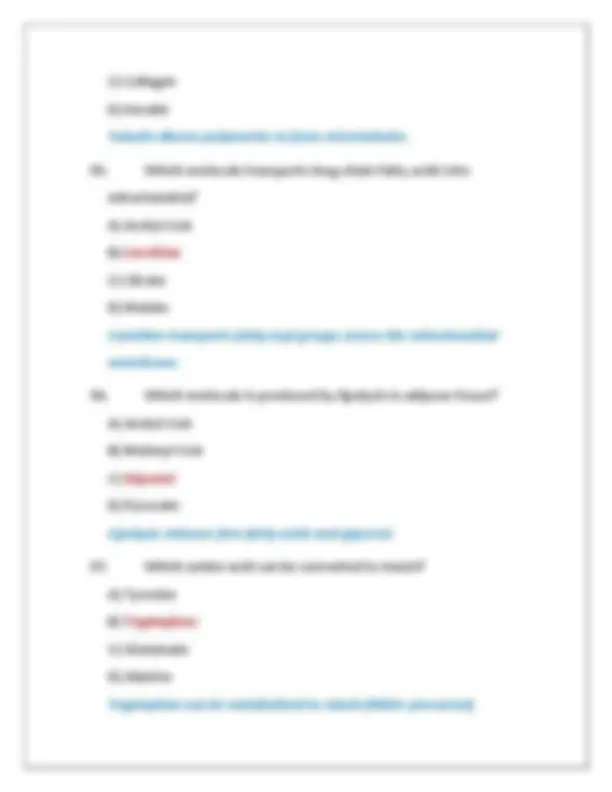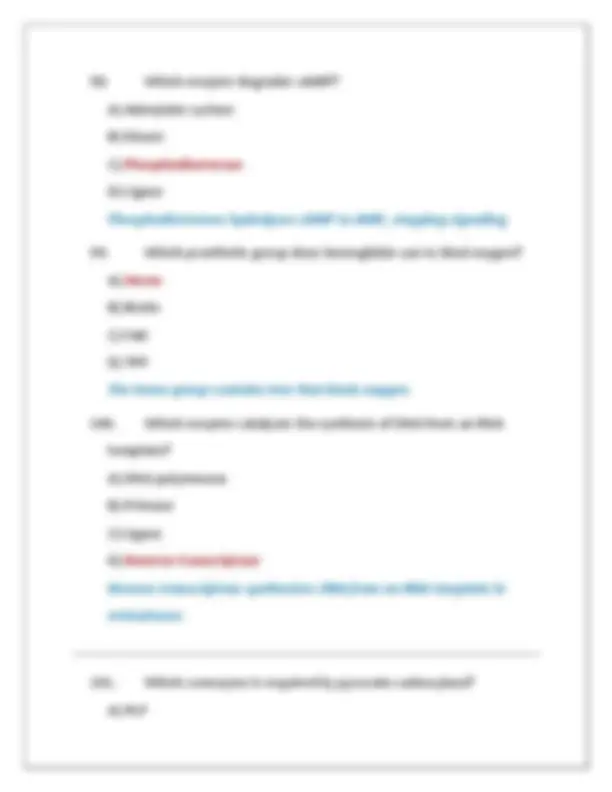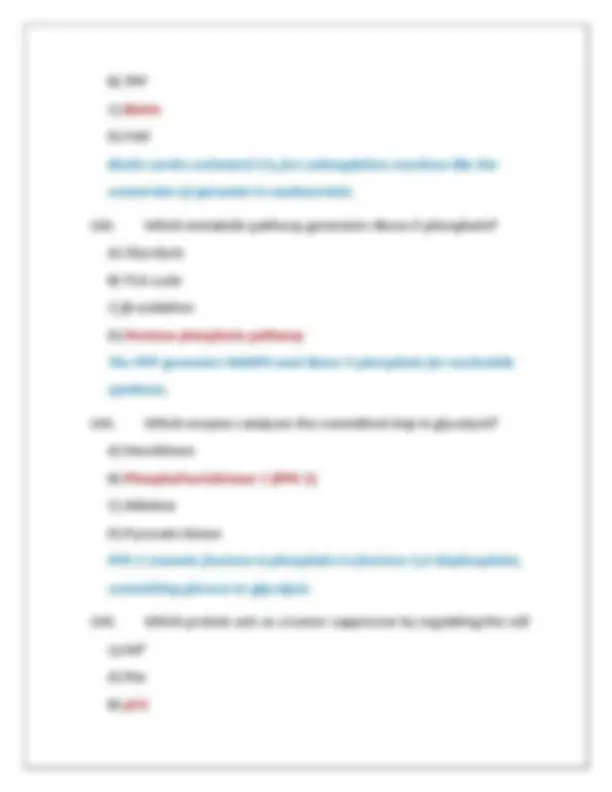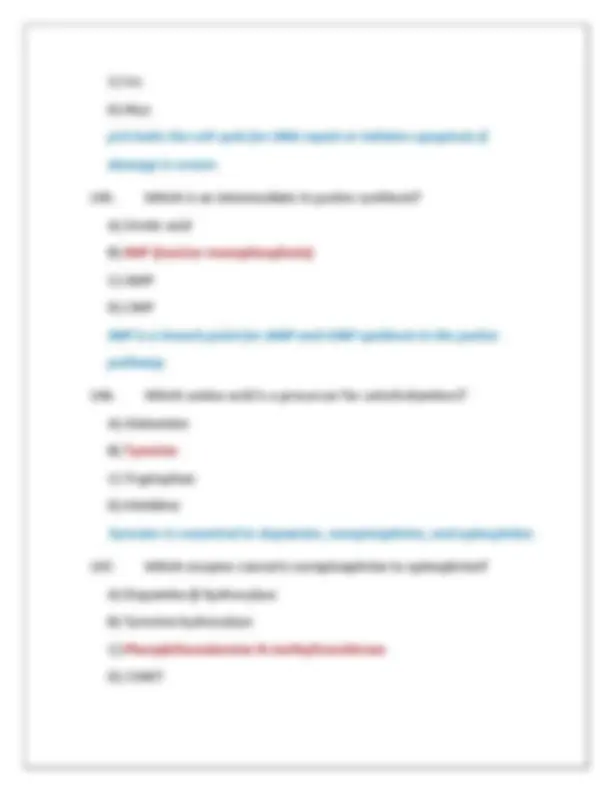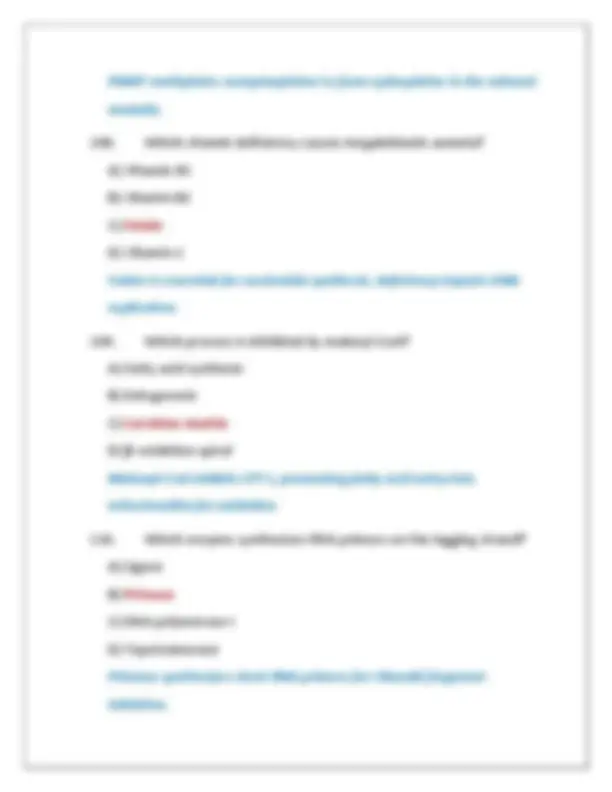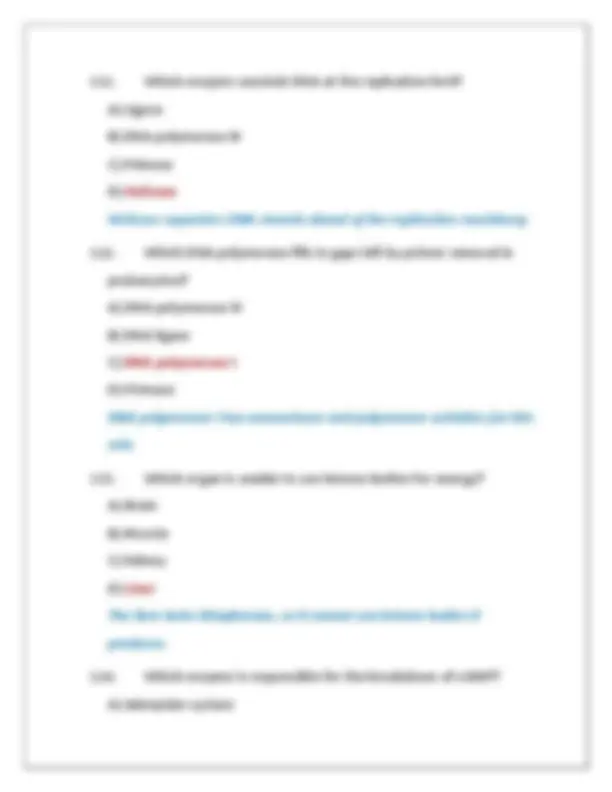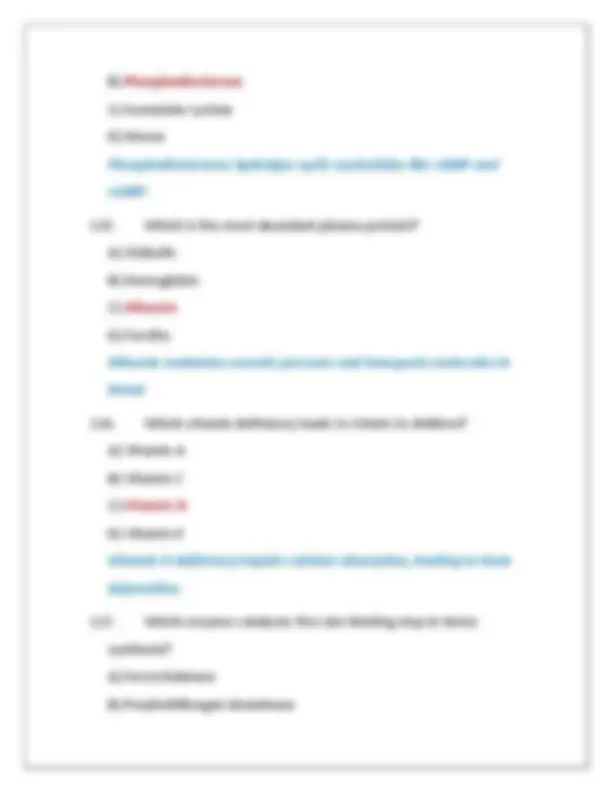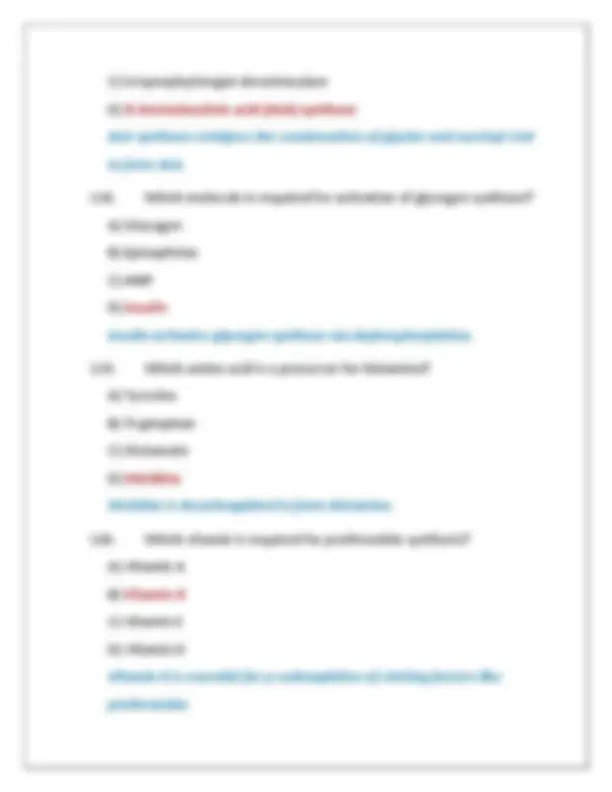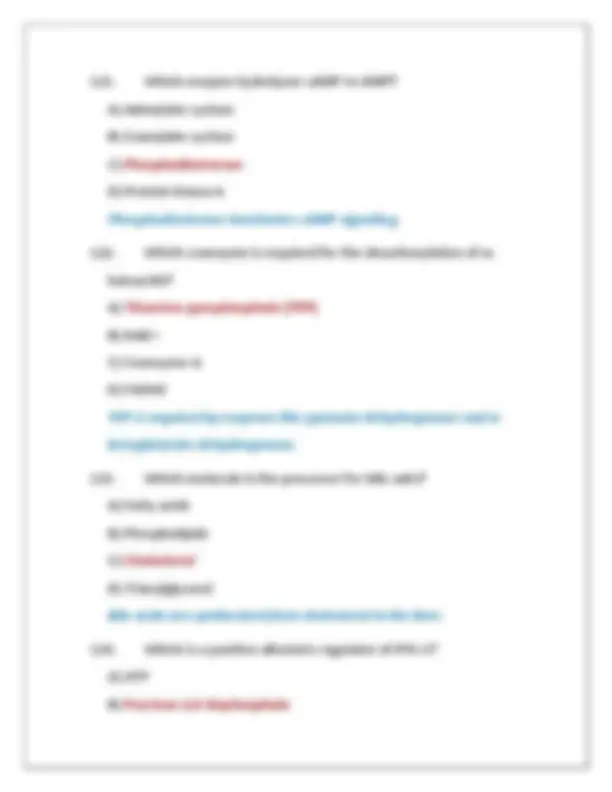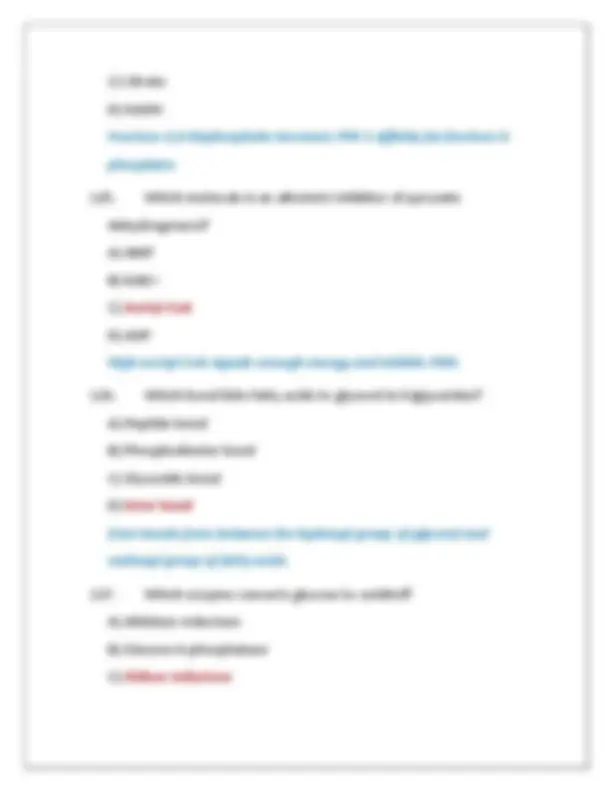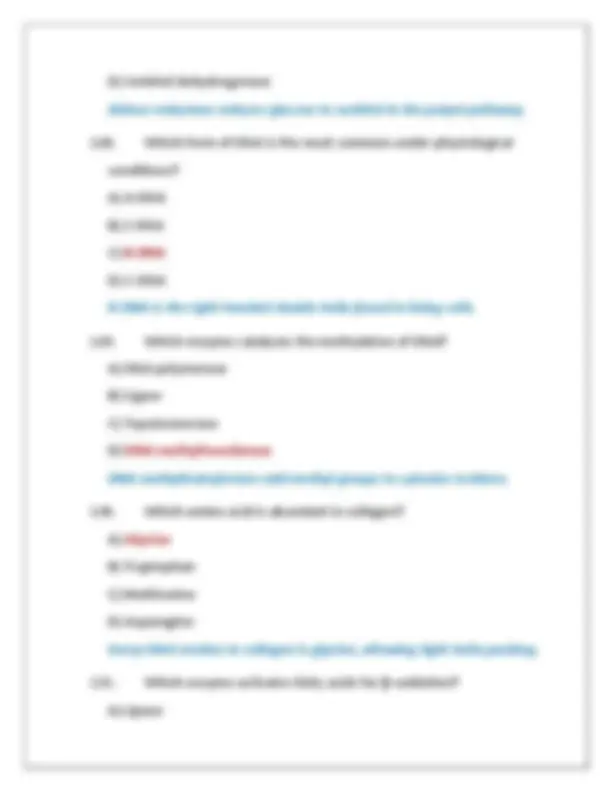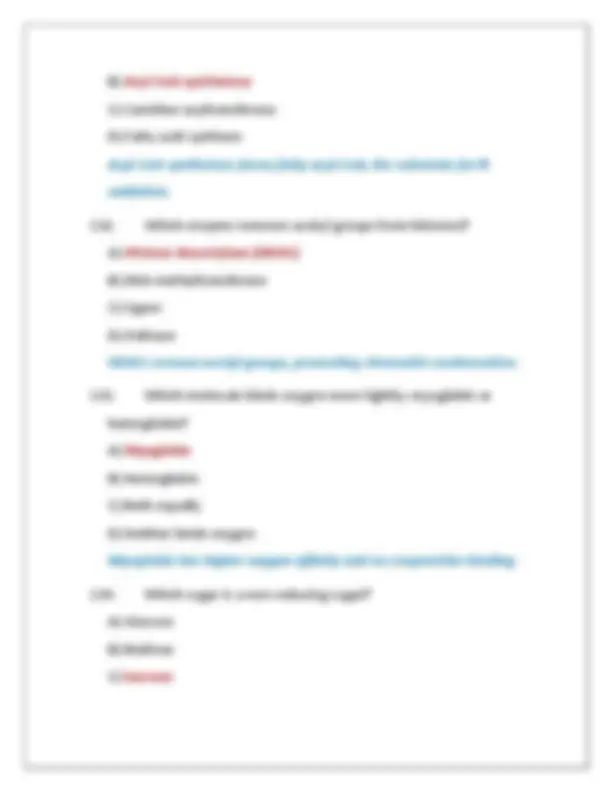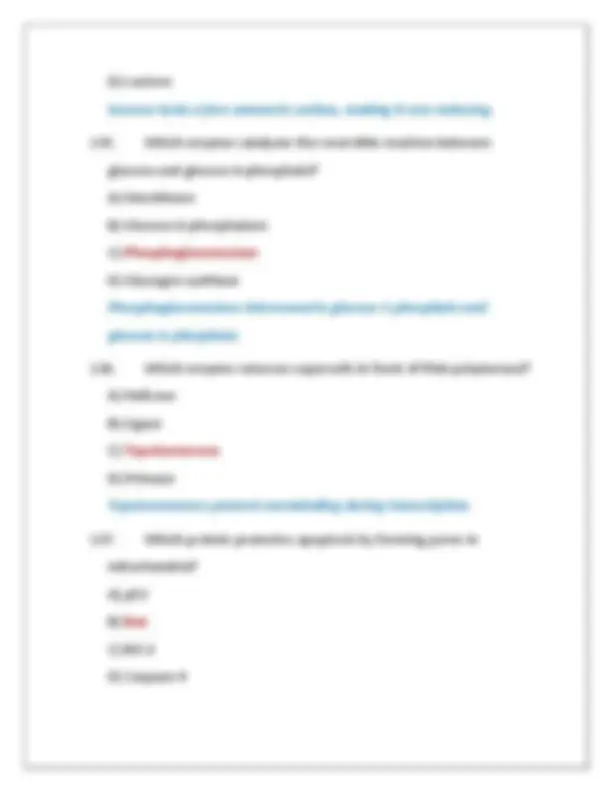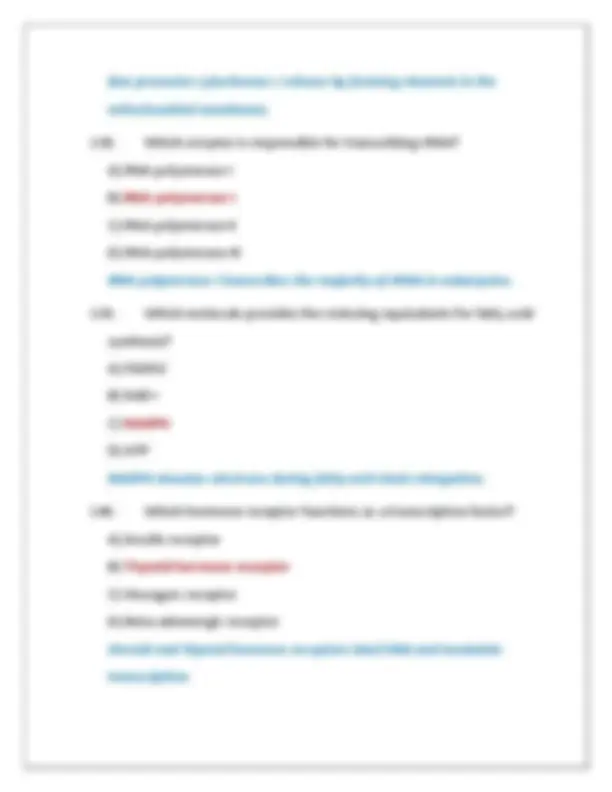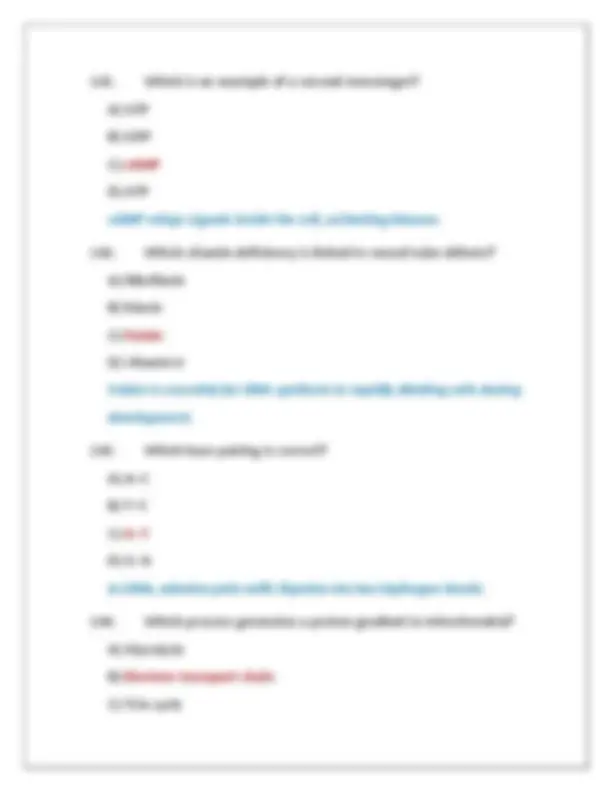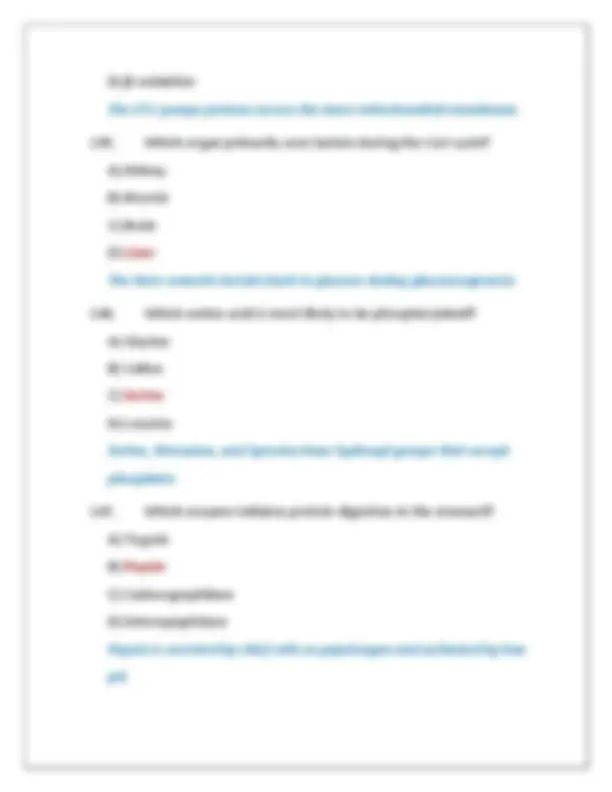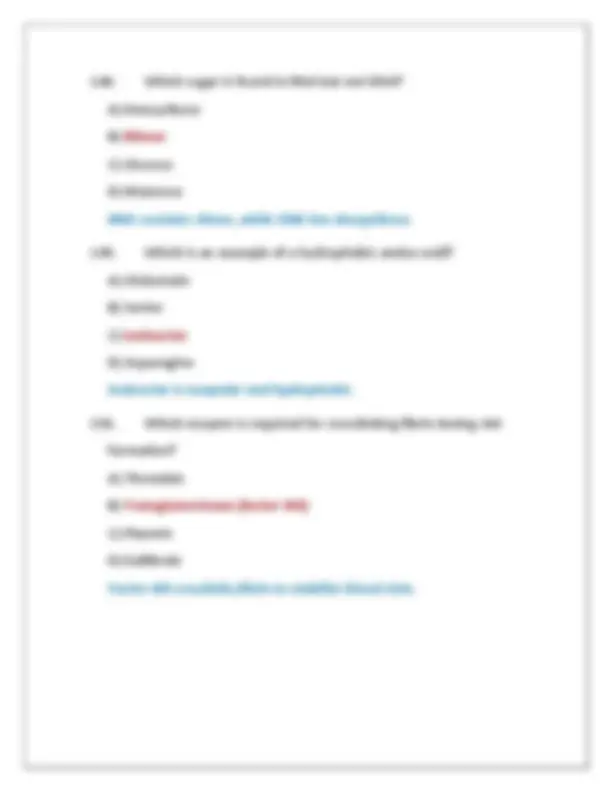Download CHEM 210 Biochemistry Final Exam 1 Practice Questions And Correct Answers (Verified Answ and more Exams Chemistry in PDF only on Docsity!
CHEM 210 Biochemistry Final Exam 1
Practice Questions And Correct Answers
(Verified Answers) Plus Rationales 2025
Q&A | Instant Download PDF
- Which amino acid is most likely to be found in the interior of a globular protein? A) Serine B) Lysine C) Glutamate D) Valine Valine is nonpolar and hydrophobic, so it prefers the interior of proteins away from aqueous environments.
- Which type of bond stabilizes α-helices and β-sheets? A) Ionic bonds B) Disulfide bonds C) Hydrogen bonds
D) Hydrophobic interactions Hydrogen bonds form between backbone amide and carbonyl groups, stabilizing secondary structures.
- What is the net charge of glutamic acid at pH 7? A) + B) 0 C) - 1 D) - 2 Glutamic acid has a carboxyl side chain that is deprotonated at pH 7, giving it a negative charge.
- Which enzyme catalyzes the phosphorylation of glucose? A) Glucose- 6 - phosphatase B) Aldolase C) Hexokinase D) Pyruvate kinase Hexokinase adds a phosphate to glucose, forming glucose- 6 - phosphate in glycolysis.
- Which vitamin is required for the synthesis of NAD+? A) Vitamin C B) Vitamin D C) Niacin D) Thiamine Niacin (vitamin B3) is a precursor for NAD+ and NADP+.
B) Tyrosine C) Glutamine D) Cysteine Leucine must be obtained from the diet because humans cannot synthesize it.
- Which enzyme is defective in phenylketonuria (PKU)? A) Tyrosinase B) Phenylalanine hydroxylase C) Dopamine hydroxylase D) Homogentisate oxidase A defect in phenylalanine hydroxylase prevents conversion of phenylalanine to tyrosine.
- Which bond connects monosaccharides in disaccharides? A) Peptide bond B) Phosphodiester bond C) Disulfide bond D) Glycosidic bond Monosaccharides are linked by glycosidic bonds in disaccharides.
- Which is the major storage form of carbohydrates in animals? A) Cellulose B) Glycogen C) Amylose
D) Starch Glycogen is the branched polymer that stores glucose in animals.
- Which molecule activates glycogen phosphorylase? A) ATP B) AMP C) Glucose- 6 - phosphate D) NAD+ AMP signals low energy and activates glycogen breakdown.
- Which hormone stimulates glycogen synthesis? A) Glucagon B) Epinephrine C) Cortisol D) Insulin Insulin promotes glycogen synthesis by activating glycogen synthase.
- Which coenzyme is needed for pyruvate dehydrogenase? A) NADP+ B) Biotin C) Thiamine pyrophosphate (TPP) D) Vitamin K TPP, derived from thiamine, is required for decarboxylation reactions in PDH.
- What is the main product of the pentose phosphate pathway? A) NADPH
- Which apolipoprotein activates lipoprotein lipase? A) ApoB- 100 B) ApoC-II C) ApoE D) ApoA-I ApoC-II activates lipoprotein lipase to hydrolyze triglycerides in lipoproteins.
- What is the major ketone body used by extrahepatic tissues? A) Acetone B) β-Hydroxybutyrate C) Acetoacetate D) Pyruvate β-Hydroxybutyrate is the major circulating ketone body for energy.
- Which enzyme removes supercoils ahead of the replication fork? A) DNA polymerase I B) Helicase C) Ligase D) Topoisomerase Topoisomerase prevents supercoiling during DNA replication.
- Which nucleotide base pair has three hydrogen bonds? A) A-T B) G-T C) A-U
D) G-C
G-C pairs are stronger due to three hydrogen bonds.
- Which process requires a primer to initiate synthesis? A) DNA replication B) Translation C) RNA transcription D) Protein folding DNA polymerase cannot initiate synthesis without an RNA primer.
- Which enzyme synthesizes the RNA primer? A) Ligase B) Topoisomerase C) Primase D) Helicase Primase synthesizes a short RNA primer for DNA polymerase.
- Which form of RNA carries amino acids to the ribosome? A) rRNA B) mRNA C) snRNA D) tRNA tRNA delivers amino acids during translation.
- Which type of mutation does not change the amino acid sequence? A) Missense
D) Exonuclease Peptidyl transferase, a ribozyme, catalyzes peptide bond formation.
- Which process removes introns from pre-mRNA? A) Capping B) Polyadenylation C) Splicing D) Translation Splicing removes introns and joins exons.
- Which histone protein helps form the nucleosome core? A) H2A B) H C) HMG D) HP H2A, H2B, H3, and H4 make up the nucleosome core.
- What is the main function of chaperone proteins? A) Hydrolyze proteins B) Assist in protein folding C) Transcribe DNA D) Modify mRNA Chaperones help proteins fold into their native conformations.
- What is the function of ubiquitin? A) Stabilizes DNA B) Activates enzymes
C) Tags proteins for degradation D) Synthesizes ATP Ubiquitin marks proteins for proteasomal degradation.
- Which enzyme hydrolyzes dietary triglycerides? A) Pepsin B) Pancreatic lipase C) Trypsin D) Lactase Pancreatic lipase breaks down triglycerides into fatty acids and monoglycerides.
- Which lipoprotein has the highest cholesterol content? A) Chylomicron B) VLDL C) LDL D) HDL LDL carries the most cholesterol to peripheral tissues.
- Which is the main fuel source during prolonged fasting? A) Glucose B) Fatty acids C) Amino acids D) Glycogen Fatty acids provide most energy during fasting.
C) Helicase D) Excinuclease Excinuclease cuts out pyrimidine dimers during nucleotide excision repair.
- Which hormone increases gluconeogenesis? A) Insulin B) Glucagon C) Somatostatin D) ADH Glucagon stimulates gluconeogenesis in the liver.
- Which amino acid is the precursor for serotonin? A) Tyrosine B) Glycine C) Tryptophan D) Histidine Tryptophan is hydroxylated and decarboxylated to form serotonin.
- Which enzyme releases fatty acids from adipose tissue? A) Lipoprotein lipase B) Pancreatic lipase C) Hormone-sensitive lipase D) Acetyl-CoA carboxylase Hormone-sensitive lipase breaks down stored triglycerides in adipocytes.
- Which sugar is a component of DNA? A) Ribose B) Deoxyribose C) Glucose D) Fructose DNA contains deoxyribose sugar.
- Which process produces the most ATP per molecule of glucose? A) Glycolysis B) Electron transport chain C) Fermentation D) Pentose phosphate pathway The ETC generates the majority of ATP during oxidative phosphorylation.
- Which hormone triggers milk ejection? A) Estrogen B) Progesterone C) Oxytocin D) Prolactin Oxytocin stimulates contraction of myoepithelial cells for milk release.
- Which vitamin deficiency causes scurvy? A) Vitamin A B) Vitamin K
- Which molecule is an intermediate in both the TCA cycle and gluconeogenesis? A) Acetyl-CoA B) Citrate C) Oxaloacetate D) Succinate Oxaloacetate links the TCA cycle and gluconeogenesis.
- Which amino acid is a precursor for nitric oxide? A) Tryptophan B) Glutamine C) Tyrosine D) Arginine Arginine is converted to nitric oxide and citrulline by nitric oxide synthase.
- Which process involves the removal of an amino group as ammonia? A) Transamination B) Peptide bond formation C) Deamination D) Oxidative phosphorylation Deamination removes an amino group, producing ammonia.
- Which enzyme catalyzes the first step of fatty acid synthesis? A) Acetyl-CoA dehydrogenase
B) Fatty acid synthase C) Acetyl-CoA carboxylase D) Hormone-sensitive lipase Acetyl-CoA carboxylase converts acetyl-CoA to malonyl-CoA, the first step in fatty acid synthesis.
- Which of these is a ketogenic amino acid? A) Leucine B) Alanine C) Glutamine D) Histidine Leucine is strictly ketogenic; it generates acetyl-CoA or acetoacetate.
- Which bond in ATP hydrolysis releases the most energy? A) Adenine–ribose bond B) Ribose–phosphate bond C) Phosphoanhydride bond D) Glycosidic bond The phosphoanhydride bonds between phosphates release energy when hydrolyzed.
- Which enzyme produces cAMP? A) Kinase B) Adenylate cyclase C) Phosphodiesterase
- What is the fate of propionyl-CoA from odd-chain fatty acid oxidation? A) Ketone bodies B) Pyruvate C) Succinyl-CoA D) Lactate Propionyl-CoA is converted to succinyl-CoA, entering the TCA cycle.
- Which enzyme is deficient in maple syrup urine disease? A) Phenylalanine hydroxylase B) Branched-chain α-keto acid dehydrogenase C) Tyrosinase D) Homogentisate oxidase Deficiency in this enzyme leads to buildup of branched-chain amino acids.
- Which enzyme activates trypsinogen? A) Pepsin B) Enteropeptidase C) Amylase D) Carboxypeptidase Enteropeptidase activates trypsinogen to trypsin in the small intestine.
- Which enzyme detoxifies reactive oxygen species? A) Catalase
B) Glutathione reductase C) Glutathione peroxidase D) NADPH oxidase Glutathione peroxidase reduces peroxides using glutathione.
- Which molecule is the storage form of iron in cells? A) Ferritin B) Transferrin C) Hemoglobin D) Cytochrome c Ferritin stores iron in a safe, bioavailable form inside cells.
- Which is a characteristic of an enzyme’s active site? A) Rigid structure B) Complementary to the transition state C) Non-specific binding D) Completely hydrophobic The active site stabilizes the transition state, lowering activation energy.
- Which factor affects enzyme activity but not enzyme specificity? A) Substrate structure B) Active site residues C) Temperature D) pH of optimum activity Temperature affects enzyme activity but not substrate specificity.

